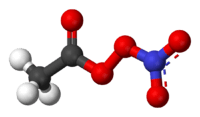Peroxyacetyl nitrate
| Peroxyacetyl nitrate | ||
|---|---|---|
 | ||
 | ||
| IUPAC name nitroethaneperoxoate | ||
| Systematic name ethanoic nitric peroxyanhydride | ||
| Other names PAN | ||
| Identifiers | ||
| CAS number | 2278-22-0 | |
| Jmol-3D images | {{#if:CC(OO[N+]([O-])=O)=O|Image 1 | |
| ||
| ||
| Properties | ||
| Molecular formula | C2H3NO5 | |
| Molar mass | 121.05 g mol−1 | |
| Solubility in water | 1.46 × 10 5 mg l−1 at 298 K | |
| log P | −0.19 | |
| Vapor pressure | 29.2 mmHg at 298 K | |
| kH | 0.000278 m³ atm mol−1 at 298 K | |
| Atmospheric OH rate constant | 10−13 cm³ molecule−1 s−1 at 298 K | |
| Except where noted otherwise, data are given for materials in their standard state (at 25 °C (77 °F), 100 kPa) | ||
| Infobox references | ||
Peroxyacetyl nitrate is a peroxyacyl nitrate. It is a secondary pollutant present in photochemical smog. It is thermally unstable and decomposes into peroxyethanoyl radicals and nitrogen dioxide gas. It is a lachrymatory substance.
Peroxyacetyl nitrate, or PAN, is an oxidant more stable than ozone. Hence, it is better capable of long-range transport than ozone. It serves as a carrier for oxides of nitrogen (NOx) into rural regions and causes ozone formation in the global troposphere.
The formation of PAN on a secondary scale becomes an issue when ethanol is used as an automotive fuel. Acetaldehyde emissions increase, which subsequently react in the atmosphere to form smog. Whereas ethanol policies solve domestic oil supply problems, they drastically exacerbate air quality conditions.[citation needed]